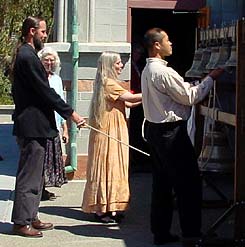Ring Like the Masters of Old!
I’d never played bells before. And certainly, I’d never organized a team of bell ringers, either. Yet I had to take our demonstrator set to a nearby parish for its patronal feast– and the bishop was going to be there! I was a little nervous at first, but we did great. I even noticed the bishop smiling whenever we rang. Now I’m an expert! How did we do it?
 |
I figured that people who like to dance, or play bongos (or violins), or even just clap their hands would make good ringers. And there's a lot of dancing and rhythm in the lives of teenagers anyway, so I headed for the younger crowd. "Ok, kids, who’s ringing? Here’s what we gotta do....!"
Bell ringing can help involve kids in church, by the way, since a fair amount of ringing goes on in connection with our services, and people naturally want to know why we ring as we do. Also, bell-ringing is an evangelical dimension of liturgical life that women have traditionally excelled at, as you can see in our video.
Organize the ringers for a little practice
So let’s say you have five bells. You can set up your bells so that one person can handle everything, but joy is good to share, so we’ll use three ringers: our leader will give the pulse with our big no. 5; one will strike nos. 4 & 3, and one will trill 2 & 1.
Poise the tongues of your bells to sing
Now hold the ropes with a little tension so you keep the clapper near the lip of the bell. I actually hold the tongues of smaller bells directly, ignoring the ropes– this gives me more control. You should be able to strike the tones with a flick of the fingers or a short jerk on the rope. Don’t let the clapper travel all the way back to vertical, but keep it near the lip so you can strike quickly and responsively, and easily keep control of your rhythm.
Use ear plugs– you can buy them at the drug store in bottles of about 20 pair. Or use industrial ear protectors– the ones that look like earphones. Also, if you keep your mouth open when you play, the sound will not affect your eardrums to harshly. Bells are loud, so take care!
Now strike a pulse and play!
Are you ready? Let the leader start with a nice, relaxed pulse on no. 5. Not too fast, not too slow: a good, steady, ambulatory pulse. "Pulse" is the key to everything rhythmic:
5... 5... 5... 5... bong... bong... bong... bong....
Once you have the basic pulse, start doing this with nos. 3 and 4 start in between those "5’s":
3-4-3, 3-4-3, 3-4-3,
ding-dong-ding, ding-dong-ding, ...
So this is what both ringers are doing together now:
5-3-4-3, 5-3-4-3, 5-3-4-3,...
Bong ding dong ding, Bong ding dong ding,....
Do that for a few measures. Finally, the person playing 1 and 2 can go ching-a-ling-a-ling, ching-a-ling-a-ling on top– improvise, try variations, be creative, have fun.
When the leader gives the signal, count out your last couple of measures and end with three big yanks on all the ropes at once–
....5-3-4-3, clang, clang, Clang!
The ringing should be a little more relaxed before the Liturgy and not too long; brighter and faster and longer afterwards. You can develop your patterns, more festive or more solemn, based on what the Typikon calls for.
If you can clap hands, you can ring bells.
It's the combination of instrument and virtuosity that creates the so-called "krasniy" ("red" or "beautiful") or "malinovy" ("raspberry") sound of Russian bells. And yes, it takes a while to learn how to ring bells properly, to produce this "raspberry sound". But learning to make this sound is well worth the trouble, considering that for years and centuries to come, this is the voice that will announce to your parishioners÷ and to the whole world÷ that it is indeed "time to begin the service to the Lord".